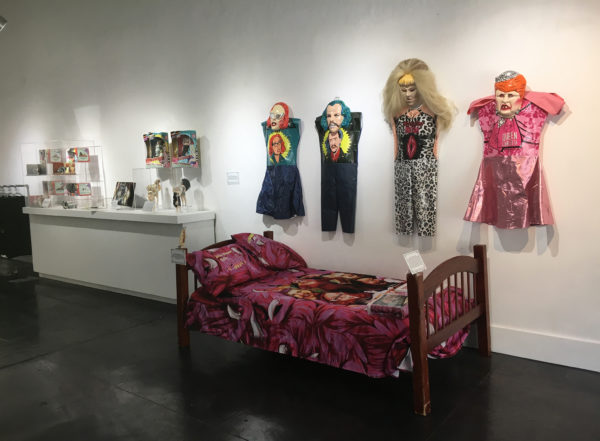Film director John Waters is best known for his trilogy of ’60s and ’70s transgressive cult cinema classics Pink Flamingos, Female Trouble, and Desperate Living. These films used a repeating troupe of actors, the most famous being the stars Divine, Mink Stole, and Edith “The Egg Lady” Massey; the actors and regular film production staff were known as the Dreamlanders, named after Waters’ production company. In the years since these films were released, the movies have achieved legendary status, for the enduring punk campiness of Waters’ social commentary ensures that each new generation discovers that these films fit their vision of both contemporary and historical avant-garde cinema.
At the time that these classic Waters films were first-run, no commercial enterprise was associated with them other than ticket sales; the overwhelming assortment of mercantile goods that now accompany a film’s release simply didn’t exist then. Recognizing the popularity of the Waters films and the absence of any legitimate merchandise for them, curator Tyson Tabbert has produced a tribute exhibition called “Lost Merchandise of the Dreamlanders”, featuring “fake” vintage retail goods for these films, items like Pink Flamingo bed sheets, Aunt Ida action figures and children’s costumes of characters from Desperate Living. Over the course of almost two years, Tabbert assembled a crew of highly talented designers to produce limited editions of such virtual merchandise, and although the devil is often in the details, it’s the details that make this show a must-see for any Waters fan.

Aunt Ida Action Figure by Tyson Tabbert, Nazareth Horner, and Bart McCoy. Handprinted Urethane Elastomer, Vacuformed PVC, 2017
The production and presentation of all the merchandise in the Dreamlanders exhibition is impeccable. Purporting to be vintage collector’s items from the 1970s, the style of the packaging is period correct and the boxes and blister packs appropriately aged. Each group of items is accompanied by a museum display card offering up a synthetic history of the production and public reaction to the merchandise. For example, very few of the Divine dolls are said to have sold because, “American girls under 12 were not ready for this kind of Barbie,” and The Queen Carlotta costumes were so unpopular that the masks were repainted and sold in the 1980s under the title “Ugly Princess.” The persuasive nature of the information is what’s really fascinating about the fake backgrounds of these items; at the opening I saw veteran fans laughing their asses off while neophytes to the Waters oeuvre were busy searching eBay to see if they could get the items at better prices.

Goldberg Company Divine Figure Character Dolls by Kyle Lords, Tyson Tabbert, Misty Greer, Stela Licina, and Jake Puppyteeth. Resin, Urethane Elastomer, Artificial Hair, Fabric,Printed Cardstock, and PVC. 2017
Although such retro-marketing is hardly innovative (action figures of Humphrey Bogart dressed as the detective Sam Spade have been available for some time now), it’s an effective methodology to expand a subject that has pretty much already been dissected and analyzed to the furthest degree possible; after all, it’s been 40 years since Desperate Living was released. What makes “Lost Merchandise of the Dreamlanders” a truly punk experience is the concept of making unsaleable merchandise for movies that were themselves were unsaleable. It’s wishful thinking taken to an almost Trumpian degree. So, next time someone talks to your hand about making America great again, tell them you’re only interested in great hair and makeup.

Earl’s 1959 Edsel Villager by Tyson Tabbert, Nazareth Horner, and Bart McCoy. Mixed Media, 2017
Lethal Amounts
1226 W. 7th Street
DTLA 90017



















Great to see such lovingly crafted items in homage to one of the great svante garde filmmakers of time, John Waters. Fake made to look genuine, as compared to our current president. Similarities and comparisons in the merchandise to the president as referenced in the article are welcome comic relief in these troubled and uncertain times.
The story was well written, articulate and well researched, infused with humor, like the artwork spoken about.
I’m sold — must see this exhibit. Hilarious! Thanks for the heads-up.